September 2010Projecting 2D Topology into 3DI started thinking about this topic while reading Surfaces, by Griffiths. When thinking about topology, I frequently instinctively wonder how the concepts presented would extrapolate to other dimensions. Take for example my love of the book Flatland, or my other Mind Wandering essay concerning "capturing" creatures from one dimension in the next lower dimension. The question I address in this brief discussion is that of finding some example topological constructions' siblings in other dimensions. Let's begin with as simple example. A point is a zero-dimensional object. What is its one-dimensional equivalent? Answer: a line segment. Two dimensions? A square. Three? A cube...and etc. Obviously, it is difficult to visualize this example in the fourth dimension or beyond. One of the simplest two-dimensional objects in topology is called a two-manifold-with-boundary. The manifold is the two-dimensional surface itself and the boundary is the one-dimensional closed line (no end-points) that defines the surface's perimeter. The simplest such shape is a circluar disk (see figure below). Now, how would we extrapolate this concept to the next dimension up: a three-manifold-with-boundary? The manifold is the two-dimensional part of the original shape so its equivalent must be three-dimensional in our extrapolation (some sort of volumetric solid). We used a circle as the actual shape of our two-manifold, so naturally we should use a sphere in the third dimension. Knowing that the shape will be a sphere virtually answers the next question: What is the boundary of our manifold? In two dimensions the boundary was a line with no end-points that looped around and closed on itself (a circle). What is the equivalent of a one-dimensional circular line in two dimensions? The boundary we are looking for is some sort of two-dimensional surface with no "end-points" which in two dimensions are line-segments (do you understand why?). This boundary (this surface) should wrap around on itself like a circle, but in the next higher dimension. It should envelop a three-dimensional interior (which we decided would be spherical for our example), analogous to the way in which a circle encloses a disk. Thus, the equivalent of the boundary of a two-dimensional disk when extended to the third dimension is the infinitely thin surface of a sphere (basically a beach-ball). However, bear in mind that the total object we are considering — the equivalent of a two-manifold-with-boundary in three dimensions — is not a beachball because that has no bounded interior, just empty space (or air). No, we want an object with a volumentrically "filled" interior, so what we really want is a billiard ball. Thus, the three-dimensional equivalent of a two-manifold-with-boundary, i.e., a three-manifold-with-boundary, is a billiard ball. 
Fig. — Disk — A two-manifold-with-boundary. Okay, let's try something harder. An annulus is a flat disk with a hole cut in it (see figure below), like a coin with a hole drilled through the center if the coin were infinitely thin, or like a Chinese bi-disk, if you are familiar with the concept. How do we describe this object? It is a two-manifold-with-boundary containing two boundaries, one inside the other. In fact, any bounded orientable manifold will always consist of one externally bounding boundary and zero or more inwardly bounding boundaries (holes). For example, you could drill multiple holes through a coin to produce multiple interior boundaries, but there is no such thing as an orientable surface with multiple exterior boundaries. What would be the three-dimensional equivalent of an annulus? The first suggestion that might come to mind is a solid torus, like a donut, but that is incorrect. First of all, a torus only has one boundary (one surface), whereas an annulus has two boundaries, so right off the bat we can tell that it is nothing like an annulus even though it has a hole of sorts. Let's build a three-dimensional annulus piece by piece the same way we built one in two-dimensions. We started with a disk, then cut a hole out of it. We know the equivalent of the disk because we established it in the previous paragraph, a billiard ball, i.e., a solid sphere. Now, how did we make an annulus? We cut a hole out of the middle of the disk. How do we do this in three dimensions to a billiard ball? Well, not by drilling through the ball like an apple-corer, that's wrong (besides which, doing so simply produces a form of torus, which we have already rejected as a candidate). We have to learn how to extrapolate our ideas to a higher dimension and the solution often isn't as simple as it first seems. The interior boundary of an annulus (in any number of dimensions) must be separated from the exterior boundary by the manifold that the two boundaries bound. They can't touch, which how we know the apple-corer idea can't be right. In two-dimensions, the interior boundary is separated from the exterior boundary by the surface of the annulus. In three dimensions the manifold is the "solidness" of the billiard ball and the external boundary is the external surface of the billiard ball...so the interior surface, the removed hole, is analogously a spherical hole removed from the center of the billiard ball, as if the ball were cut in two, each half was scooped out with a melon-baller, and the two halves were glued back together again, leaving a cavity in the middle (see figure below). Such an object is the equivalent of an annulus in three dimensions (which is absolutely nothing like a torus of course). Cool, huh? 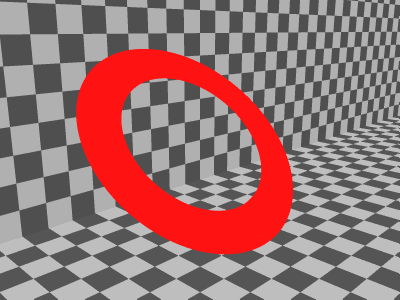
Fig. — Annulus. 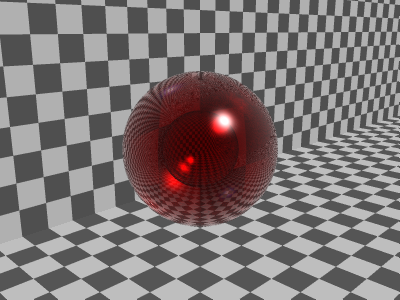
Fig. — 3D Annulus — Two spherical boundaries, one inside the other, bounding a volumetric solid between them. Thus, the inner sphere (the bubble) is empty. See next figure for further clarification. 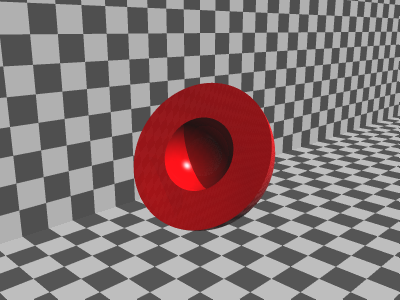
Fig. — 3D Annulus — A 3D Annulus cut in half so you can better understand the interior boundary. Here's a little assignment. A annulus can be converted to a 'C' by cutting out a section of the surface (see figure below). What would be the analogous conversion on our three-dimensional annulus? What would the resulting object look like? Think about it before reading on... 
Fig. — 'C' — An annulus with a section removed to join the two boundaries. ...okay, we'll need the answer to the previous question before proceeding, so here it is. The analagous "removal" on our three-dimensional annulus is a hole drilled from the exterior into the interior cavity (see figure below). Notice that in both cases, the number of boundaries has been reduced from two to one (sharp corners don't break the concept of a single contiguous surface). The annulus's boundaries are the interior and exterior one-dimensional edges while the three-dimensional annulus's boundaries are the interior and exterior two-dimensional surfaces, and the addition of the cut-away-hole in both cases joins the two boundaries into a single boundary. If you think about this for a moment, you will realize that this 'C' is now topologically identical to (homeomorphic to) a (two or three)-manifold-with-ONLY-one-boundary, i.e., a disk in two dimensions and a billiard ball in three dimensions. Can you convince yourself that a 'C' is in a fundamental way identical to a disk? Imagine stretching and otherwise steadily reshaping the 'C' into a disk? That transformation is possible because they are topologically the same object (homeomorphic). The same principle applies to the three-dimensional case of course. Fig. — 3D 'C' animation — A cylinder has been drilled out of the 3D annulus to reveal the inner cavity. Before proceeding I must define a few concepts, namely ways in which manifolds can be joined. In two dimensions our manifolds are surfaces and if those surfaces have an edge (a one-dimensional boundary) we say they are a two-manifold-with-boundary. We have seen that the simplest example is a filled circle, a disk, like a pancake. Two surfaces can be joined in three ways: ears, twisted ears, and bridges. An ear is a surface which is joined to another surface such that two subsections from the same boundary of the ear are joined to two subsections of the same boundary of the other surface, i.e., only two boundares are involved, one on each surface, and in each case, two different subsections along the boundary are involved in the join. A twisted ear works exactly the same way but the ear receives a half-twist between its two joining subsections. If you have any experience with constructing Mobius strips, this is the same idea (incidentally, a Mobius strip is simply an annulus with a half twist, so after our thorough consideration of annuluses this ought to be fairly simple to visualize). We'll come back to Mobius strips later (we will attempt to "solve" the question of describing a Mobius strip's three-dimensional equivalent, much like we did with the annulus). The third way in which two surfaces can be joined is a bridge. A bridge is one surface which is attached to another surface such that two subsections on the bridge are joined to two different boundaries of the other surface. Notice that twisted ears and bridges are not planar; they cannot reside wholly within a perfectly thin plane and thus any surface that contains a twisted ear or a bridge cannot reside wholly within a plane. The main purpose of this section has been to work up to bridges, in particular so we can consider objects like the bridged annulus (see figure below). Study the figure and make sure you understand what a bridged annulus is and how the bridge component satisfies the definition, i.e., one surface attached to another surface (the annulus) at two difference boundaries (the inner and outer boundaries of the annulus). 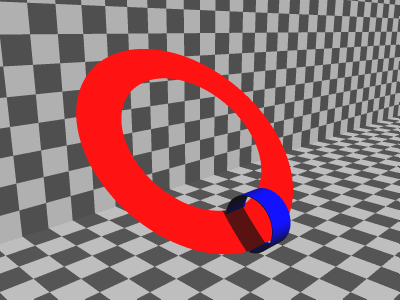
Fig. — Bridged Annulus. Things will be more complicated from this point forward because we will soon have to consider a fourth spatial dimension. This is particularly difficult because we can't visualize such objects perfectly, but with some practice we can "infer" their characteristics. The long term question I want to try to solve is, what is the three-dimensional analogy to a torus, i.e., an inner-tube (or a hollow donut) (see figure below). We will get there, but we will start with some simpler ideas and sneak up on it. 
Fig. — Torus — Note: it is empty, not a volumetric solid, i.e., an inner tube, not a donut. First, we will consider a punctured torus. This is a torus with a small patch removed from its surface (see figure below). While this might seem like a more complicated object, it turns out that it is easier to reason about. The first thing we must realize is that a punctured torus is topologically identical too (homeomorphic with) a bridged annulus. Imagine that the torus is pressed down slightly against a hard tabletop so that its footprint is flattened. Then imagine that we stretch the puncture along the torus's radial axis all the way down to the footprint on both sides (so instead of a small hole we now have a thin slit that almost severs the torus, but not all the way through the flattened footprint. Now, imagine that we further stretch the puncture around the concentric axis. Stretch it almost all the way around the torus to the far side. What we now have is a thin band that wraps up, over, and back down around the virtually destructed torus. Clearly, this is no longer a torus in the conventional sense, but rather is a bridged annulus. Remember, unlike an ear, a bridge attaches two different boundaries. The band in our case attaches to the inner and outer boundaries of the annulus, thus it is a bridge. So we have proven that a punctured torus is topologically homeomorphic to a bridged annulus. Ta da! 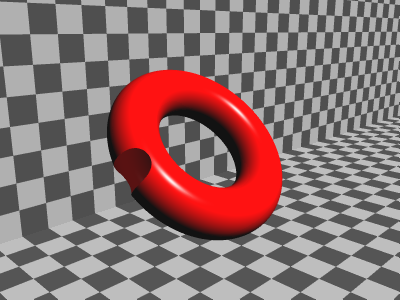
Fig. — Punctured Torus — Notice it is empty, not a volumetric solid, i.e., an inner tube, not a donut. It is homeomorphic to the bridged annulus. Now, we already know the three-dimensional equivalent of an annulus. It is a billiard ball with a cavity scooped out of the center. We even know the equivalent of a 'C'. It is a billiard ball with a hole drilled into the cavity. Now, here's a tough question: our first four-dimensional question: What is the equivalent of a bridged annulus in three-dimensions? You already know what a three-dimensional annulus is we've seen it above (a billiard ball with the center scooped out). How would you bridge it? Think about this before reading on... In the two-dimensional case, a bridged annulus consists of adding a new surface whose boundary (a one-dimensional edge) joins the two boundaries of the annulus. Everything must scale up by one dimension in our analogy. So the additional thing we must add is not a surface but a volumetric solid of some sort. The solid's (a three-manifold incidently) boundaries are not one-dimensional edges but two-dimensional surfaces. So this thing is basically a lump of clay of some sort, three-dimensional in its expanse and two-dimensional in its boundary (its surface). What we joined in the two-dimensional case was subsections of the surfaces' boundaries (1D), so what we must join in our three-dimensional case are subsections of the solids' boundaries (2D). To sum up, we need to take our three-dimensional annulus (a billiard ball with a cavity in the center) and we need to add another volumetric piece (a lump of clay) such that the the new piece's boundary (its surface) joins (merges) with the two existing boundaries of the annulus (the inner and outer surfaces of the cavitied billiard ball. Well, okay, it easy enough to say we will press a piece of clay against the outer surface of the billiard ball, and it is easy to say we will stick a piece of clay against the inner surface of the cavity (if we imagine teleporting the piece of clay into the cavity to begin with), but how could we possibly do both joins to both surfaces with the same piece of clay?! That is what we need an analogy for with respect to the two-dimensional case. This is where the fourth dimension becomes essential to our experiment. Our lump of clay will join each of the two surfaces on our three-dimensional annulus and will curve up and through the fourth dimension to make its two ends meet. In fact, it isn't right to say the clay extends outward from the exterior surface of the billiard ball at all — it fits entirely within the three-dimensional confines of the original annulus, just the way a bridged annulus fits within the two-dimensional confines of a normal annulus if you look straight down at it. The bridge in the two-dimensional case doesn't extend outward from the annulus within its original plane. Rather, it extends "up" into the third dimension. The same will be true in our speculative scenario of a three-dimensional bridged annulus (see figure below). Fig. — 3D Bridged Annulus animation — Despite a similar appearance to the 3D 'C', shown above, this object is quite different. The cylinder is not a hole. It is actually a double-volume, a region of 3D space where two 3D volumes reside without touching due to their separation in the fourth dimension (actually, they do touch along the circular faces at the two ends of the cylinder where the associated surfaces join together. Look at the 2D bridged annulus to understand how it works.). It helps to practice visualizing or imagining two volumetric solid objects cohabiting in the same three-dimensional space. This is easier if you imagine that the two objects are made of translucent material, like jello. Visualize a translucent billiard ball with a cavity in the middle. Because it is translucent you can actually see the cavity (what you are seeing is refraction effects at the interior surface of the cavity between the jello and the air in the cavity). Now, imagine the opposite of the hole we drilled when forming a 'C'. Instead of removing a cylinder, imagine an additional cylinder of jello superimposed in the billiard ball's space such that this cylinder reaches through the depth of the billiard ball's thickness from the exterior to the interior. Lastly, imagine that at the exterior and interior edges of the billiard ball (and the ends of our jello cylinder), our additional cylinder of jello actually merges with the billiard ball's solidness through the overlapping area of the surface subsections (circles), but that inside the "thickness" of the billiard ball between the exterior and interior surfaces these two solids aren't actually touching one another (since the cylinder is raised up into the fourth dimension), just like the bridge in the two-dimensional case). If you can visualize such an object, you have successfully visualized the three-dimensional equivalent of a bridged annulus. We are getting close to visualizing the three-dimensional equivalent of a torus. Bear in mind that I am referring to a hollow torus, like an inner tube, not a solid torus, like a donut. We will first proceed by undoing the transformation we used to convert a punctured torus into a bridged annulus. To undo this we take our bridge and stretch it concentrically around the annulus until it almost meets on the opposite side of the annulus, leaving a thin slit across the annulus. Then we pull the ends of the slit back up so the puncture becomes a small hole again. Let's do that to our three-dimensional bridged annulus. To do this we expand our additional jello cylinder in diameter. Imagine that it stretches to a wider and wider cylinder. It rapidly reaches the point where it no longer looks like a cylinder because it is wrapping around the curvature of the billiard ball. At the halfway point, our "cylinder" is the equivalent of cutting our original cavitied billiard ball in half to reveal the interior. At this halfway point, one half of our three-dimensional annulus (the cavitied billiard ball) is ordinary and the other half is fully superimposed by the expanding bridge, what started out as a thin cylinder. Bear in mind that this half is now two solid objects coexisting in the same three-dimensional space (but separated in the fourth dimension). Continue expanding around the backside of the billiard ball until the cylinder almost fully encompasses the original annulus and the space remaining resembles the hole we considered drilling to form a 'C'. Bear in mind that this hole isn't empty however because the original annulus is still there! Are you keeping up with me? At this point we have constructed the three-dimensional equivalent of a punctured torus. By now, you my have already completed the puzzle. How do we convert a punctured torus into a normal torus? We add a cap, a small two-manifold-with-boundary (a disk, a surface with a single edge). The cap perfectly fits over the puncture and merges boundary-to-boundary (edge-to-edge in two dimensions) and the puncture (and cap) vanish, leaving a normal torus. To do this in three dimensions we "undo" the action of drilling a hole from the exterior of the cavitied billiard ball into the interior by plugging the hole with a cork, i.e., a small cylinder of clay. Notice that the analogy always works in the same way, by scaling all dimensions up by one. A cap is a two-manifold-with-one-boundary (a surface with one edge). A plug is a three-manifold-with-one-boundary (a solid with one surface). The plug fits into the hole and merges (surface to surface) with the boundry of the hole. What we are left with is an unbroken cavitied billiard ball, much like our original three-dimensional annulus, but now the entire volumetric expanse of the billiard ball is "doubled up" in the fourth dimension — anywhere we look at the annulus we are seeing two solids residing in the same three-dimensional space, like two jello lumps that intersect (see figure below). Can you imagine such an object? If so, then you have successfully visualized a three-dimensional torus. Fig. — 3D Torus animation — This animation attempts to make the critical point about visualizing projections of fourth-dimensional objects (four-manifolds) into three-dimensional space, which is that the same location in 3D space can be occupied by multiple distinct 3D objects. When these two objects perfectly align, and if their surfaces are then fully joined to one another point for point, they become a 3D torus. Let's go a little further. A Mobius strip is an annulus with a twist (by twist we always mean half-twist). What we always learn as children about Mobius strips is that they have only one side. This is true, but they have another interesting feature. Whereas an annulus has two boundaries, a Mobius strip only has one. It is important to think about these things because these are the features which should extend analogously when we extend an object into another dimension...which is what we're going to do right now. We will construct the three-dimensional equivalent of a Mobius strip. Feel free to stop at this point and try to do it on your own, but the solution may surprise you. It's definitely weird. First, what do we start with? A Mobius strip is a transformation of an annulus. We will use the same approach in three dimensions, so we will start with our three-dimensional annulus, the cavitied billiard ball. It's amazing how simple it is to now conjure up the image of a three-dimensional annulus at the drop of hat isn't it? You may have had absolutely no idea what such a thing was when you started reading this article and now you could carve one out of a watermelon on command. Now, how do the features of a Mobius strip extend to the next dimension up? An annulus's surface has two sides, but a Mobius strip's surface has one (topologists say an annulus is orientable while a Mobius strip is not). This should extend to the next dimension. How so? Think about it a bit, we'll come back to it. Furthermore, an annulus has two boundaries (inner and outer edges), but a Mobius strip has only one which crosses itself at a special location on the annulus. Again, how should we expect this to extend to the next dimension up? It is also interesting to recall that the Mobius strip is made through the use of a twisted ear and that both twists and bridges cannot reside within a true plane, i.e., any surface that has twists or bridges is slightly three-dimensional. This analogy will hold too — that is to say: extending a two-dimensional object that is slightly three-dimensional into three dimensions will produce a three-dimensional object that is slightly fourth-dimensional (we suffered greatly with this with our bridged annulus and its three-dimensional equivalent). So a three-dimensional Mobius strip should be a three-dimensional annulus in which the two "sides" of the volumetric solid are joined (the sides are three-dimensional so this is tricky), and in which the two boundaries are joined at a special cross-over point (the exterior and interior surfaces of the billiard ball must somehow join), and finally it must be slightly fourth-dimensional (so we can predict right off the bat that we won't be able to truly visualize it in three dimensions). How are we going to do this? Let's not think about the surface. That's the normal way to think about a Mobius strip, but let's concentrate on the boundaries, the edges. Imagine an ant walking along an annulus, but not across the surface, rather right along the edge. The ant will travel around the outer edge, then along the edge of the twist crossing over to the inner edge, then around the inner edge, then across the twist again to the outer edge to start all over. Thus, there is only one edge. Our three-dimensional Mobius strip should offer similar behavior, i.e., an ant walking across the surface of the ball should, at the location of the twist, cross over to the inner surface of the cavity and vs/va. Notice how in the two-dimensional case, the ant "dips inward" toward the inner edge as it traverses the twist. Likewise, in the three-dimensional case, the ant should "sink in" toward the center of the ball. We accomplish this by pushing a dimple into the outer surface of the ball. Likewise, the interior cavity surface should dimple outward. The two dimples should meet at a point — that is the point where in the two-dimensional case the two edges cross (see figure below). Fig. — 3D Mobius Strip animation — The inner and outer dimples meet at a point. This is the cross-over point, the twist in a 2D Mobius Strip. In order to traverse across the twist, one must rise up into the fourth dimension, which we can't see here. See next figure for further clarification. Fig. — 3D Mobius Strip animation — A 3D Mobius Strip cut in half so you can better understand the cross-over point (the twist). At this point you might raise an objection. In the two-dimensional case, the ant can clearly follow the edge around the Mobius strip, crossing from outer to inner edge at the twist. There is clearly a problem in the three-dimensional case however. The dimples don't "go through" to the other side. As the ant descends into the dimple, it gets stuck at the bottom. To understand the solution, notice that in the two-dimensional case, the ant can only cross over or under the point of the twist by rising or lowering into the third dimension, i.e., the ant cannot follow the twisted boundary in the true two-dimensional plane. Likewise, in the case of the three-dimensional Mobius strip, the ant must "rise up" into the fourth dimension to cross the point of the twist, the two adjoining dimples. While a two-dimensional Mobius strip is "slightly three-dimensional" due to the twist, a three-dimensional Mobius strip is correspondingly "slightly fourth-dimensional" due to its analogous twist. We have considered a number of examples of extending manifolds from an initial dimension to their equivalent in another dimension (up one dimension in most cases). Specifically, we considered extending two-manifolds (surfaces) to three-manifolds (solid volumes). We considered relatively simple manifolds (disks and annuluses) and considerably more complex manifolds (hollow toruses and Mobius strips). If you want to try yet another level of complexity in this thought process, consider how the methods described here would govern extending three-manifolds into four-manifolds. What would it be like to construct the four-dimensional equivalent of a solid sphere, which is itself the three-dimensional equivalent of a disk? What about a solid torus? Have fun. |